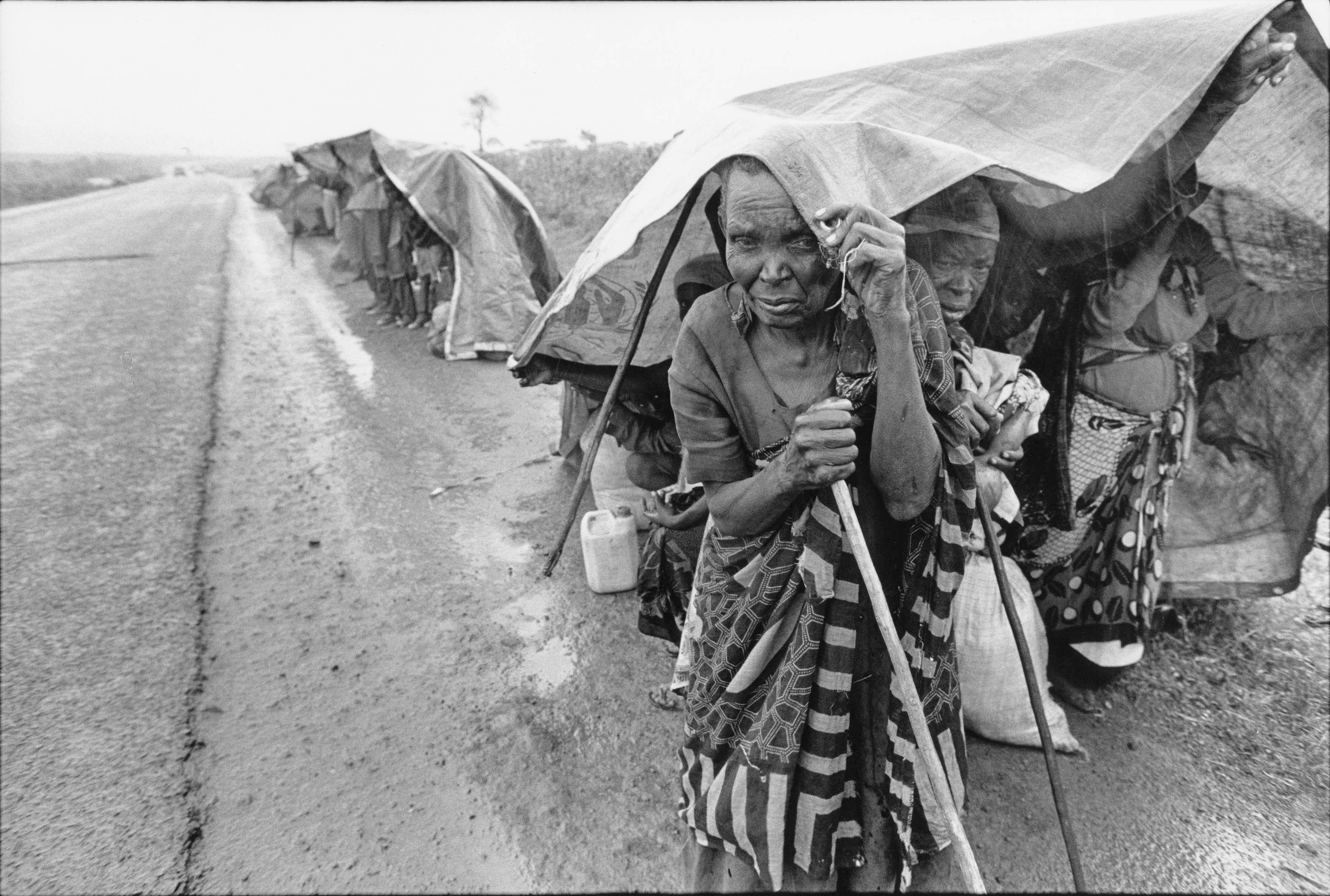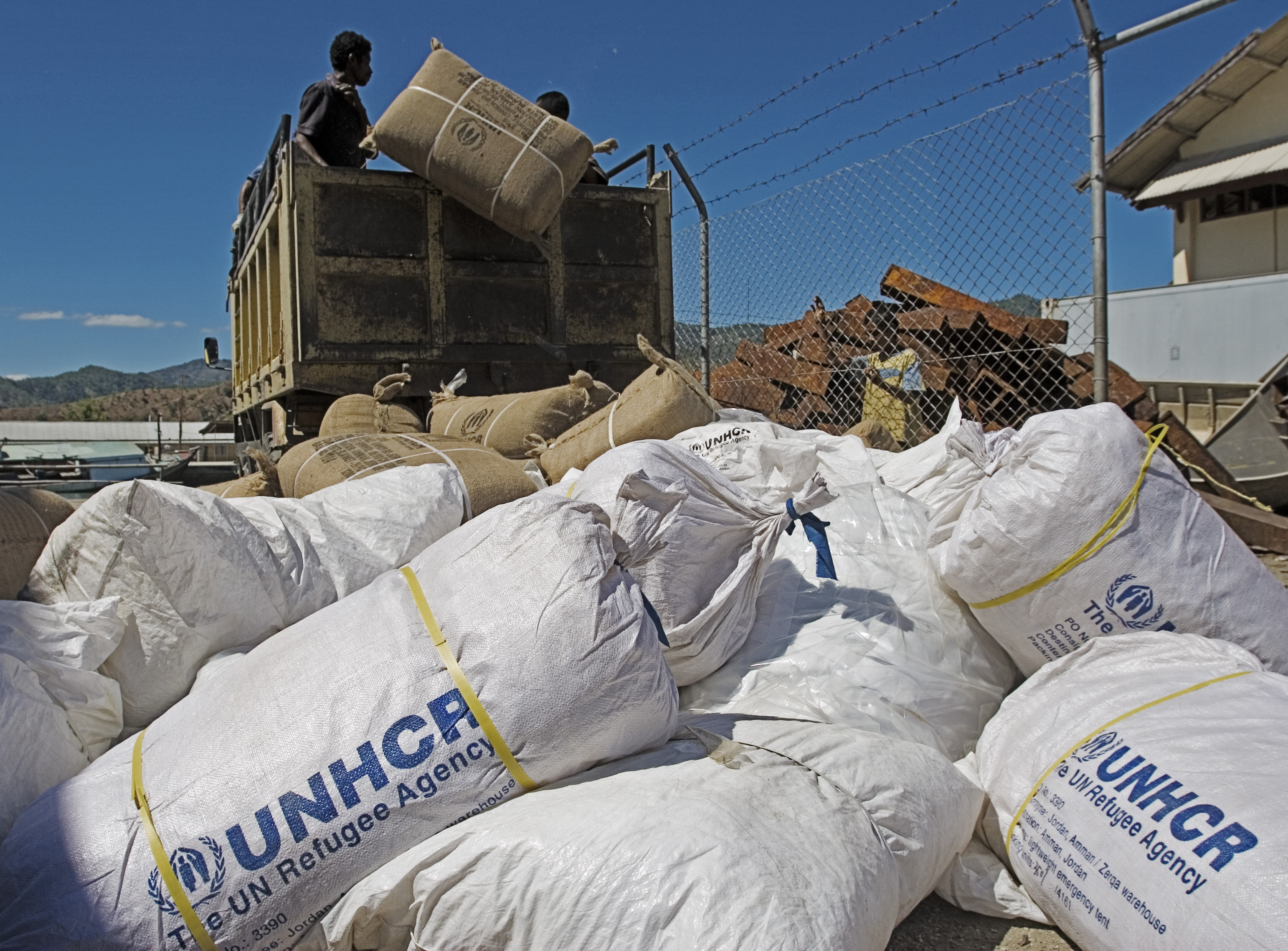Lego poster: Teachers' guide
Lego poster: Teachers' guide

Apprehension: Rwandans head home after genocide.
Human Rights, Refugees and UNHCR
A refugee is a person who "owing to well-founded fear of being persecuted for reasons of race, religion, nationality, membership of a particular social group or political opinion, is outside the country of his nationality and is unable or, owing to such fear, is unwilling to avail himself of the protection of that country." (from the 1951 Convention Relating to the Status of Refugees)
When the Office of the United Nations High Commissioner for Refugees (UNHCR) was established in 1951, there were an estimated 1 million refugees to care for, the majority of whom were European. At the start of 2006, UNHCR cared for 20.8 million people, of whom 8.4 million were refugees. Eighty per cent of them are women and children. In addition to individual flight from persecution, the modern pattern of refugee movements is that of mass exoduses caused by ethnic conflicts and violations of rights of minorities.
People become refugees because one or more of their basic human rights have been violated or threatened. The Universal Declaration of Human Rights (UDHR) underlines the strong connection between human rights and the work of UNHCR. Article 14 of the UDHR states that "everyone has the right to seek and to enjoy in other countries asylum from persecution."

UNHCR has delivered 1,054 plastic sheets, 1,000 blankets and 1,054 jerry cans to Mota Ulun at the base of the hills near Hera. Leader from six area hamlets organized the distribution of items.
The work carried out by UNHCR, whether involving protection or material assistance, is influenced by human rights considerations. Violations of human rights are one of the main causes of mass exoduses; they also eliminate the option of voluntary repatriation as long as the violations persist.
No one likes or chooses to be a refugee. Being a refugee means more than just being a foreigner. It means living in exile and often depending on others for basic needs such as food, clothing and shelter.
Where most people can look to their own governments to guarantee and protect their basic human rights and physical security, refugees cannot do so. Rather, their country of origin has proved itself unable or unwilling to protect those rights. UNHCR has been mandated with the responsibility of ensuring that refugees are protected by their country of asylum, and assists asylum countries. Its main role is to ensure that states respect, their obligations to protect refugees and persons seeking asylum and solutions.
A refugee has the right to safe asylum. However, international protection comprises more than physical safety. Refugees should receive the same rights and basic help as any other foreigner who is a legal resident, including certain fundamental entitlements of every individual: refugees have basic civil rights, including freedom of thought and of movement, and freedom from torture and degrading treatment. Similarly, economic and social rights apply to refugees as they do to other individuals. Every refugee should have access to medical care. No refugee child should be deprived of schooling.
Suggested activities using the posters to launch discussions concerning refugee issues
Have copies of three of the four posters in the classroom. Do not display Spot the Refugee yet.
As the teacher may not choose to use all the posters in class, a couple of the discussion questions in the lesson activities below have been repeated. If using all the posters, ignore the repeated questions.
When watching news reports and documentaries about the massive refugee flows which have occurred in the last decade, students may wonder how they can contribute their part to international cooperation to solve these tragedies. Students may sense that they are powerless to help, but this is not the case.
Introductory questions for the students
- Who produced these posters?
- Do you think the posters are advertisements for Lego? If not, why not?
Ask the students what similarities all the Lego people share? (Responses could include: all the figures have similarly-shaped yellow heads; the facial features are usually the same, i.e. two black spots for the eyes and a smile; they all have similarly-shaped hands, although pirate figures can have a hook instead of a hand; they all have a body and legs which are also similar in shape, but pirate figures can have a stump instead of a leg!)
Ask how they think the manufacturers make a Lego figure resemble a woman or a girl? (Possible replies could include: select a feminine hairstyle, female clothing, pastel colours, etc).
Spot the Refugee
Place a copy of the poster on the wall, folded, so that the writing is not visible. Ask the students to look closely at the rows of Lego people. Ask them to suggest an identity for each figure, beginning from the first Lego person in the first row. After several have been identified, ask the students by what means they decided upon each identity? For example, did they look at the clothes, the facial appearance and/or the gender?
The students are informed that the people who designed this poster decided that one of the figures is supposed to be a refugee. Ask the students to spot the refugee, and to describe how they came up with their identification. Do any of their reasons match the descriptions written on the blackboard at the beginning of the lesson?
This is an important lesson in the dangers of prejudice and stereotyping. The students should be brought to understand the harm which can be caused by ignorant, thoughtless name-calling and attribution of negative characteristics to a whole social group.
Now unfold the poster to reveal the text and allow the students time to read the information quietly by themselves.
Comprehension and discussion questions
- Ask the students to write answers to the following questions in their notebooks.
- What is the one difference between refugees and you and me?
- What events do you think could have happened to cause a person to flee and leave everything behind?
- What types of experience might refugees endure during their flight?
- How would you feel if you were a refugee who had to leave your home, family and possessions behind and live in another country?
- Define the term 'open mind'. What does it mean? Why does UNHCR ask that people keep an open mind and a smile of welcome?
Discuss the answers to these questions around the class. Refer to the concept of discrimination and discrimination.
How Does It Feel?
If the class is used to working in small groups, give each group one of the following scenarios and ask them to discuss among themselves how they would feel if they were:
- a new student who has just joined their class in the middle of the school year
- a child of their age who has been holidaying with his/her family in another country where the language is foreign, and the child has somehow been separated from the other family members
- someone who has just heard the bad news that the breadwinner of the family no longer has a job
After a suitable time has elapsed, the students can reassemble as a class group, and are led by the teacher to share the fruits of their group discussions.
Now turn the class' attention to the UNHCR Lego poster How Does It Feel? Allow the students a few minutes to take in the picture and to read the text.
Comprehension and discussion questions
Use these questions as the basis of a discussion:
- Thinking about the three situations we just discussed, what similar feelings might the lonely Lego person have?
- What similarities and differences are there between the situation of the lonely Lego figure and the three cases we just considered?
- What do you think the people who designed this poster are trying to suggest through the way the Lego figures have been arranged?
- Who do you think is the intended audience of this poster?
- What attitudes towards refugees is UNHCR encouraging people to adopt in this poster?
What's Wrong Here?
Discussion questions
UNHCR has the responsibility to ensure that refugees are protected in their country of asylum and assists refugees by coordinating the provision of shelter, food, water, sanitation and medical care in emergency situations.
- What causes a person to be refugee?
- Why would a refugee have nothing?
- How does UNHCR suggest, through this poster, that individuals can help refugees?
- Do the students agree?
- What else can governments do to protect the rights of refugees?
- What responsibilities do you think refugees might have in their host countries?
- What contributions do you think refugees could bring to their host countries?
What's The Difference?
Refugees have frequently been successful in finding asylum in neighbouring countries. Having found asylum, the refugees are safe from the persecution that they feared in their own home countries, but they may face the difficulty of not being thoroughly integrated in their new country.
Discussion questions
- What is the difference between each Lego figure?
- If there is no difference, why is there a different name underneath each one?
- Why do you think some people call other people nasty names?
- If you had to divide the Lego people into two groups, how would you do it? Would you group you and me in a small group of two, and put the refugee with the rest? Or, would you group the last three Lego people, the refugee, you and me, together? Give your reasons for your decision.
- re-read the last two sentences. What do you think is the message of these sentences?
Conclusion
Referring to all the posters, ask the students how they have previously regarded refugees about whom they have seen news stories, and how have they viewed refugees who live in their community. Do they sense any change within themselves, concerning their attitudes towards refugees, since starting this unit of work? What changes are there? The teacher needs to guide this discussion with sensitivity, encouraging the students to be frank, but being assertive if students rudely challenge each other over differing viewpoints.
UNHCR has delivered 1,054 plastic sheets, 1,000 blankets and 1,054 jerry cans to Mota Ulun at the base of the hills near Hera. Leader from six area hamlets organized the distribution of items.


